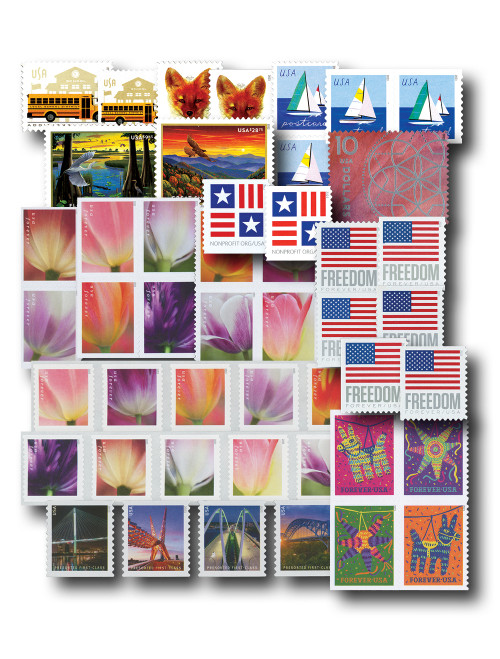U.S. #622
1926 Regular Issue
13¢ Benjamin Harrison
First Day of Issue: January 11, 1926
First City: Washington, D.C., Indianapolis, IN
Quantity Issued: 130,867,400
Printing Method: Flat Plate
Perforation: 11
Color: Green
Why Was U.S. #622 Issued?
With no obvious need for it, the 13¢ stamp was originally left out of the Series of 1922. Four years later, the 1926 13¢ Benjamin Harrison stamp appeared – for no apparent reason.
Some believe it was issued to satisfy Postmaster New, whose father was a close political ally of President Harrison. Others point out that 13¢ paid the combination postage and insurance on parcels valued between $25 and $50.
The original design, picturing giant Sequoia trees, was changed to portray former President Harrison. Regardless of the intent, U.S. #622 is now an integral stamp of the Series of 1922.
Benjamin Harrison and Postmaster General Harry New
After moving to Indianapolis, Indiana, at the age of 21 to establish his political and legal career, Harrison became close with John New. (John was the father of Harry New, the Postmaster General at the time this stamp was issued.) In fact, as President, Harrison made John New consul general of the U.S. to London. The younger New was later elected to the same Senate seat Harrison once held. Due to their long history, Harrison was a hero to Harry New, who likely had the idea for placing him on the 13¢ stamp and personally selected the image.
Harrison’s Life and Career
Benjamin Harrison was born August 20, 1833, in North Bend, Ohio. Benjamin’s family was one of the First Families of Virginia and his grandfather was 10th U.S. President William Henry Harrison. In spite of this, Benjamin wasn’t raised in a wealthy household, as his father used most of their money to fund his eight children’s educations. Benjamin enjoyed a happy childhood filled with hunting and fishing.
In 1847, he entered the Farmer’s College near Cincinnati, Ohio. He later transferred to Miami University in Oxford, Ohio, graduating in 1852. Harrison then began a successful law career at the law office of Storer and Gwynne in Cincinnati. After marrying Caroline Lavinia Scott, Harrison moved to Indianapolis, Indiana, where he continued to practice law and served as the city’s Federal Court crier. In 1856, he was elected Indianapolis City Attorney. Two years later, Harrison opened the law office of Wallace and Harrison.
When the Civil War first began, Harrison wished to serve in the Union Army, but he knew he needed to continue to provide financial support for his family. However, when Governor Oliver Morton requested his help, he agreed and was commissioned as a Second Lieutenant. For Harrison’s first two years of service, he and his troops mostly guarded railroads. But in 1864, they finally saw military action, and continued to fight until the end of the war. By the time Harrison left the army, he had risen to the rank of brigadier general.
After leaving the army, Harrison served as reporter of the Supreme Court, represented the federal government in a civil case, and served as a U.S. Senator, all while continuing his own law practice.
Harrison was elected President in 1888. His administration is most known for its economic legislation. Also, more states were admitted to the Union during his term than any other since George Washington.
After leaving the White House, Harrison continued to practice law. He died March 13, 1901, in Indianapolis, Indiana.
U.S. #623
1925-26 Regular Issue
17¢ Wilson
Issue Date: December 18, 1925
First City: New York, NY; Princeton, NJ; and Staunton, VA
Issue Quantity: 122,059,800
Woodrow Wilson (1856-1924)
28th President
Woodrow Wilson was born December 29, 1856, in Staunton, Virginia. One of Wilson’s earliest memories was of a man standing at his family’s front gate, saying, “Mr. Lincoln’s elected. There’ll be war!”
The devastation of the Civil War delayed his formal education until he was nine. Wilson graduated from New Jersey’s prestigious Princeton University in 1879, and then attended the University of Virginia’s law school. He practiced law in Atlanta, Georgia, but opted for a career in education. Wilson served as President of Princeton University from 1902-10, and gained national recognition as an educational and social reformer at Princeton.
The Democratic Party took notice, and Wilson was persuaded to run for governor of New Jersey in 1910. In that capacity, he continued his progressive politics. Two years later, he was the Democratic nominee for president. A bad split in the Republican Party helped Wilson win an electoral landslide. In 1916, the election results were so close that Wilson went to bed thinking he had lost. However, the next day he discovered he had won by a narrow margin.
Historians regard Wilson as one of America’s most successful presidents. He led the nation through World War I and enacted many successful legislative reforms. Under his leadership, tariffs were lowered, the Federal Trade Commission was created, and the 18th (banning alcohol) and 19th (women’s suffrage) Amendments to the U.S. Constitution became law. President Wilson also helped to negotiate the conclusion of the first World War and worked on the Treaty of Versailles.
Wilson was successful as a scholar, teacher, university president, political leader, and statesman. He is also remembered for his integrity, sense of responsibility and great honesty. Wilson spent the last years of his presidency supporting the League of Nations. He won the Nobel Peace Prize in December 1920, for his efforts in securing peace and supporting the League of Nations.












